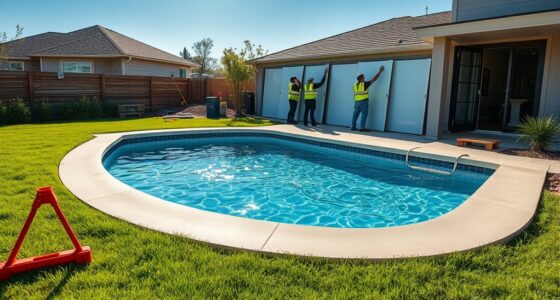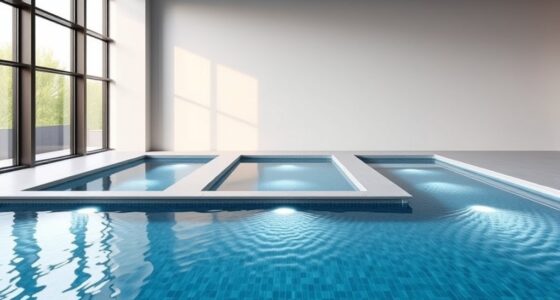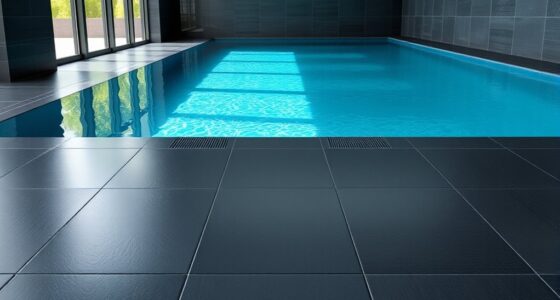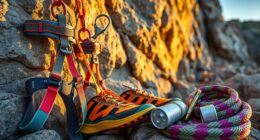To optimize your swimming training, focus on adjusting water flow rates and speeds to control resistance and improve technique. Moderate speeds help refine form, while higher speeds boost strength and power by increasing water resistance. Using equipment like paddles and resistance devices allows you to tailor the challenge. Monitoring and gradually increasing flow rates can push your limits safely. Keep experimenting with different speeds and tools—more tips ahead will help you maximize your performance.
Key Takeaways
- Adjust water flow rates to simulate race conditions and vary resistance for targeted muscle engagement.
- Use equipment like resistance pools and flow control devices to precisely manage water speeds during training.
- Monitor water speeds to tailor workouts that improve technique, strength, and endurance effectively.
- Moderate flow rates help refine technique, while higher speeds increase resistance for strength development.
- Understanding hydrodynamics allows for strategic manipulation of water resistance to optimize training outcomes.

Understanding water flow rates and speeds is essential for effective training, whether you’re preparing for a race or improving your swimming technique. When you grasp how water moves around you, you can tailor your workouts to maximize efficiency and build strength. At the core of this understanding are hydrodynamics principles, which explain how water interacts with your body. These principles reveal that as your speed increases, so does the aquatic resistance you face. This resistance acts as a natural form of strength training, challenging your muscles and cardiovascular system simultaneously.
Hydrodynamics principles show that water’s density and viscosity create resistance proportional to your velocity. When you push off the wall or glide through the water, the faster you go, the more force you need to overcome this resistance. That’s why training at different flow rates can help you develop power and endurance. By controlling your pace, you can simulate race conditions or focus on technique, understanding how varying speeds influence resistance. For example, swimming at a moderate pace allows you to refine your form, while higher speeds push your muscles to adapt to increased resistance.
Training at different flow rates builds power and endurance by simulating race conditions and adjusting resistance levels.
Knowing about aquatic resistance helps you manipulate water flow to your advantage. Using tools like kickboards, paddles, or resistance bands, you can increase the effective resistance during training sessions. This targeted approach enhances muscle engagement and improves propulsion efficiency. You might also experiment with different flow rates by adjusting your swimming speed or using specialized equipment to create specific resistance levels. This way, you can train in a way that aligns with your goals, whether it’s increasing power or refining technique. Additionally, modern training methods incorporate water flow control to optimize resistance levels and monitor progress effectively.
Monitoring your water flow speeds provides valuable feedback on your progress. For example, swimming against a current or in a resistance pool allows you to measure your pace relative to water velocity. By doing this, you gain a better sense of your capabilities and can set realistic targets. Additionally, understanding how flow rates affect your effort helps you avoid overtraining or injury. Instead, you can develop a balanced training plan that progressively challenges you while allowing ample recovery.
Frequently Asked Questions
How Do Water Flow Rates Affect Swimming Endurance?
Higher water flow rates increase resistance, making your muscles work harder during swimming. This resistance training boosts your endurance by challenging your muscles and cardiovascular system. As you push against stronger currents, you improve your cardiovascular health and stamina more effectively. So, adjusting water flow rates can help you train smarter, building endurance faster and enhancing overall swimming performance. Keep in mind, proper flow management maximizes your workout benefits.
What Equipment Is Best to Measure Flow Speed Accurately?
Think of yourself as an explorer, seeking precise flow data. The best equipment includes flow measurement tools like electromagnetic or ultrasonic flow meters, which provide accurate readings. To guarantee reliability, use proper calibration techniques, comparing measurements against known standards regularly. These tools allow you to monitor water flow speeds precisely, helping you optimize training and track progress effectively in your aquatic environment.
Can Flow Rates Be Adjusted During a Training Session?
Yes, you can adjust flow rates during a training session. Most equipment allows for flow rate adjustments on the fly, so you can modify the water speed to match your training needs. This flexibility helps you increase or decrease the intensity as you progress. Just make sure you have easy access to the controls and monitor the flow rate changes to maintain safe and effective training throughout your session.
How Do Flow Speeds Impact Different Swimming Styles?
Flow speeds markedly impact your swimming styles by altering hydrodynamic resistance and flow patterns. Faster flows increase resistance, challenging your strength and technique, especially in freestyle and butterfly. Slower speeds create smoother flow patterns, ideal for focus on form. By analyzing flow patterns, you can optimize flow speeds for each stroke, enhancing efficiency. Adjusting flow speeds helps you train smarter, improving endurance and technique while reducing fatigue.
Are There Safety Concerns With High Flow Rates?
High flow rates can pose safety concerns, but proper flow regulation enhances hydrodynamic safety. You should always monitor flow speeds to prevent accidents and guarantee swimmers stay within safe limits. While vigorous currents might seem thrilling, they can cause fatigue or disorientation if not controlled. By maintaining appropriate flow rates, you protect yourself and others, turning challenging conditions into safe, effective training environments.
Conclusion
So, next time you think about training in water, remember—you might just be racing against your own limits, or maybe the water’s speed will remind you who’s really in charge. Ironically, the faster the flow, the easier it seems to forget how much the water’s doing the work. But don’t worry, whether you win or lose, you’ll definitely get a splash of wisdom—and maybe a little humility along the way. Happy training, and watch out for those sneaky currents!










